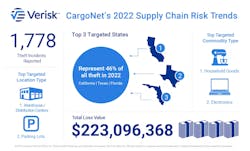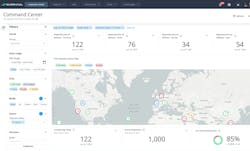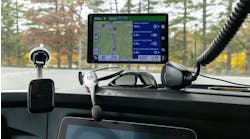Cargo theft is on the rise. Theft prevention and recovery network CargoNet reported that almost 1,800 claims of pilferage were made by its members last year—an increase of 15% from 2021, which saw fewer than 1,300 incidents reported. As 2023 has passed into spring, that surge of thefts hasn’t slowed, with thefts traditionally concentrated on the West Coast now spreading farther east.
“One of the things that we are starting to see, and I predict is going to be a long-term trend, is the shift of strategic and fraudulent thefts moving to the East Coast and more eastern states,” said Danny Ramon, who is the intelligence and response manager at supply chain risk management company Overhaul, which offers asset-tracking and theft-recovery solutions. “We’ve seen it start already in Indiana and Illinois, as well as Georgia and a couple of other East Coast port cities.”
This migration of strategic theft eastward follows an increase in shipping container traffic to eastern U.S. states, Ramon said, as cargo theft follows cargo density. Another factor making those areas enticing for thieves is that, because they don’t traditionally see as much strategic pilferage, many shippers and brokers out east do not vet their carriers as thoroughly, making it easier for loads to be obtained fraudulently, he said.
As cargo theft trends upward and eastward, carriers can use technology to stay one step ahead of the criminals.
Route planning for the worst-case scenario
“You’ve got to have a route plan in place,” said Tom MacCallum, VP of loss control at IAT Insurance Group, “regardless of whether you run the same lanes, or whether you know you’re always doing a different run every week.”
CargoNet—which gets its data from law enforcement, member and nonmember carriers and brokers, and internet scrapes—offers a lane-assessment tool that fleets can search to see not only what routes are high-risk but also what commodities thieves are targeting.
MacCallum also underscored the importance of carriers understanding the commodities they’re hauling to properly assess risk. He said the riskiest items pre-pandemic were cargo such as pharmaceuticals, electronics, and high-end clothing. And even though for some time during and after the pandemic other types of cargo such as baby formula were being targeted, trends indicate thieves have returned to stealing many of the same items they did before COVID-19.
“The numbers are extremely important,” said Keith Lewis, CargoNet’s VP of operations, “but pay attention to more of the trends—in the commodities, the locations.” Carriers must focus on their loads that travel through the most high-risk areas with the cargo that is most likely to be targeted, Lewis added.
If drivers must travel through high-risk areas with cargo coveted by thieves, they should plan their routes so they don't have to make stops in danger zones, he said. If drivers have no choice but to operate in these areas, they should allot time to be fueled, rested, and fed before picking up loads so they can haul that coveted freight out of theft zones without stopping.
Connected truck platform Drivewyze, through its optional Safety+ subscription, integrates monthly CargoNet data to alert drivers via their ELDs if they travel through one of America’s 50 riskiest counties or enter the 50 riskiest truck stops. Additionally, every 24 hours, Drivewyze’s Safety+ uses CargoNet Incident Alerts to let drivers know if they have entered an area where there was a recent theft. Safety+ alerts work in all 50 states.
Drivewyze’s sales director of safety solutions, Andrew Diesel, said drivers may not always be able to avoid certain areas, but the alerts raise awareness so they and their dispatchers and safety personnel can minimize the risk together.
“Sometimes that's where a driver has to stop. They’re out of hours. That’s understandable,” Diesel added. “The idea is for the drivers to take action, whether that’s stopping their vehicle safely to call their dispatcher and ask them to help them to find another spot, or if it's just to be extra cautious.”
Drivewyze also allows fleet managers to draw geofences along designated freight-hauling routes. Drivewyze will alert managers if a truck leaves its geofenced area, allowing managers to contact the driver to see whether a detour is legitimate.
Fleets also can use Drivewyze to set custom safety messages for drivers when they enter a geofence. Diesel said Drivewyze has customers who use the feature to notify drivers—especially new drivers—when they enter a lane, region, or neighborhood that is riskier for cargo theft.
See also: Security experts advise caution ahead of holiday weekend
Preventing pilferage
“One of the biggest threats out there is just being pilfered,” said Ronald Green, Overhaul’s VP of business development. He said experts often refer to pilferage as the partial or complete stealing of cargo from a trailer rather than the theft of an entire trailer full of freight, which happens less frequently.
To prevent pilferage, Overhaul offers technology that can detect when a trailer door is opened and can detect when its interior is exposed to light. The company also is working on sensors to detect when a trailer door seal has been tampered with or removed, according to Green.
“We have a Bluetooth seal coming to market, which is just a standard cable seal with a Bluetooth sensor, and if that cable seal is cut or removed, a Bluetooth sensor will pick that up and communicate that out,” he said.
Jordan Dewart, president of Redwood Logistics’ operations in Mexico, has seen trucks use door sensors that transmit location data every time they are opened.
“I've seen, on very high-value cargo, door sensors that are linked to the GPS so that they track when and where those doors open,” Dewart added. “So no matter how you pull those doors off … it'll track as soon as those magnetic connectors are broken.”
See also: Incomplete data, strained law enforcement enable cargo thieves
Scott Cornell, transportation lead and crime and theft specialist at insurance provider Travelers, said despite their apparent simplicity, locks are “underrated” for preventing pilferage and trailer theft. He cited landing gear locks for trailers, kingpin locks for fifth wheels, and air-cuff locks for brakes as options.
“Cargo thieves do not want to spend 20 minutes grinding through a lock,” Cornell said. “They want something they can be able to take quickly and be off-site quickly."
Redundant asset tracking improves security
Using trailer telematics, fleets can track cargo by the trailer load. However, there are cases in which carriers place tracking devices within cargo to protect against pilferage. RFID tags often are used, as are devices that utilize GPS or cellular location data to track cargo, said Nick Martin, an IAT loss-control specialist.
IAT’s MacCallum also noted: “Each one gets better and better with time, but so do the thieves.”
MacCallum said he has seen insurance claims where the GPS device has been covered with a barrier or had its cord cut to prevent it from emitting signals, or the thieves pull the truck and cargo into a building for the device to lose connection. Some thieves, Martin added, use jamming devices to block signals from getting in and out of the trailer.
Jim Zeitunian, chief technical officer at Powerfleet, a software provider that offers a suite of asset-visibility and security solutions, said Powerfleet often installs aftermarket tracking technology to support OEM devices; the redundancy allows the company to track stolen cargo even if an OEM tracking device has been disabled.
“What we're finding, especially in heavy equipment, OEM devices are discovered and worked around fairly quickly,” Zeitunian added. However, aftermarket secondary devices, cleverly installed to look innocuous or not like a device at all, are less likely to be tampered with, he said.
As for carriers operating in remote areas, Redwood Logistics’ Dewart recommends not relying only on cellular devices, saying satellite-based GPS tracking is more reliable where cell towers might be few and far between.
Increasing visibility: The watchdog of the future
The future will bring an increasingly granular view of the supply chain, possibly including a scenario in which most shipments will be traceable by pallet and parcel. The technology is theoretically available now, but it is cost-prohibitive. However, as tracking solutions such as Bluetooth devices become more affordable, granular end-to-end supply chain visibility will approach reality for more and more companies, allowing them to better ensure that their freight stays safe and arrives where it should.
“We’ve seen tracking devices which 10 years ago were $500—now they’re $30,” said Overhaul’s Green. By driving costs down, tracking technologies will be deployed more widely across the supply chain.
See also: As cargo theft continues to rise, experts advise on prevention and spotting fraud
According to Zeitunian, Bluetooth technology is not only becoming cheaper, but its range is increasing, with Bluetooth 5.2 emitting signals as far as 240 meters (or 820 ft.), able to easily broadcast through a standard 53-ft. trailer to a nose-mounted gateway "clear as day."
He also said companies have already created low-power Bluetooth devices with 3D-printed solar cells on them, and as the technology is further developed and becomes more cost-effective, he foresees Bluetooth being used more widely in cargo at an increasingly detailed level.
According to Green, "Everybody from ports to airports to railheads and rail operators are all embracing technology," adding that "there's a clear path where all the different supply chain players in logistics network operators … are more and more integrated, more and more willing to share data, which will streamline operations and also streamline security in many cases."
Green added: "Data Integration 10 years ago was not very common in the carrier world," but now it's commonplace among large carriers, whose fleet managers can integrate data through their brokerage network and carriers for real-time visibility.
"Their data integrations are becoming more standardized as we move," Green said. "It's just the natural maturation process of the industry adopting a standard set of data points that can be easily communicated through an API setup to other parties."
Intelligence platforms, such as Powerfleet's Unity, are becoming increasingly "device agnostic and data agnostic," according to Zeitunian, who said that Unity can process information from third-party sources. He gave the example of a Powerfleet customer in Mexico whose insurer offered lower rates if the company had telematics in place for security.
"What we were able to do with them is take the local crime statistics from the various reporting agencies and blend them into a powerful heat map," he said. By being able to look at risk at a granular level rather than over a broad area, the carrier was able to understand their risk portfolio and more safely haul freight, which in turn reduced insurance costs, he said.
AI-enabled cameras are another technology developing at an accelerated pace as machine learning algorithms are more widely deployed.
"The holy grail for video is object recognition," Zeitunian said. Cameras are available for trailer interiors from Powerfleet and other providers, but he said he sees a future in which, instead of video recordings being used for forensics after a theft, cameras could be utilized to proactively alert law enforcement or security personnel. If object recognition improves to the point where a camera could accurately recognize if an individual is brandishing a gun, it could create an alert without the need for human intervention.
With so many connected devices, there is the possibility of companies having their cybersecurity breached and intruders gaining access to the information on shipments. "There's an example in the Port of Rotterdam a couple years ago where their system was penetrated and criminals used that information to target specific containers," Green noted.
IAT's Nick Martin suggested companies review their internal cybersecurity practices, including training employees to be selective about what information they disclose and not to click on suspicious links.








